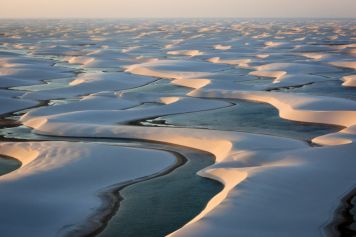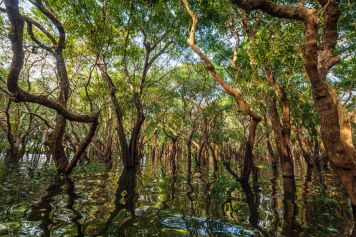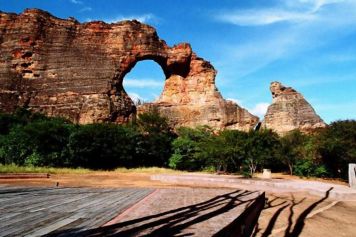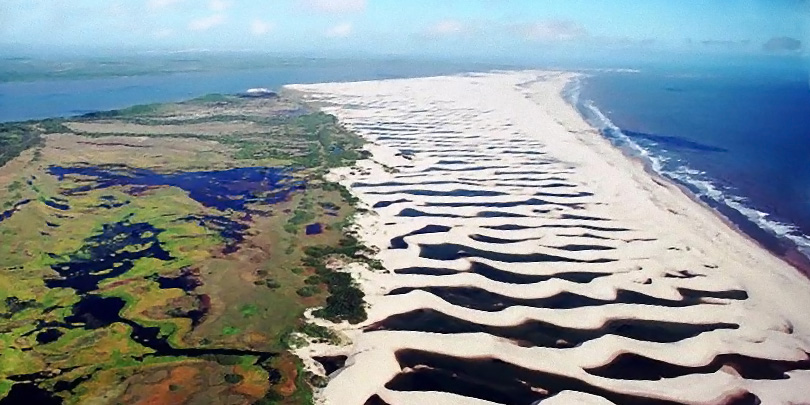Description
- Lençois Maranhenses National Park:
Magical sand dunes - In the Delta of the Rio Parnaíba:
Stunning nature scenes between river and ocean - Serra de Ibiapaba with the Ubajara National Park and the Sete Cidades National Park:
Tabletop mountains, green spa oasis with breathtaking waterfalls, bizarre rock formations, mystical caves and prehistoric wall drawings
Short Description of the Natural Highlights
Lençois Maranhenses National Park
 The Lençois Maranhenses National Park was founded in 1981 and covers 155,000 ha, 90,000 of them are characterised by dunes and lagoons in-between them. The national park is part of the bioma coastal region consisting of coastal landscapes, mangrove forests and promontories with sand dunes and scarce vegetation. A combination of different landscapes that is unique on our planet. The most known place among tourists Barreirinhas, whereas the small towns of Atins and Santo Amaro are our secret hints, a little more remote but less frequented and very close to the dunes and lagoons.
The Lençois Maranhenses National Park was founded in 1981 and covers 155,000 ha, 90,000 of them are characterised by dunes and lagoons in-between them. The national park is part of the bioma coastal region consisting of coastal landscapes, mangrove forests and promontories with sand dunes and scarce vegetation. A combination of different landscapes that is unique on our planet. The most known place among tourists Barreirinhas, whereas the small towns of Atins and Santo Amaro are our secret hints, a little more remote but less frequented and very close to the dunes and lagoons.
To get there 4x4 vehicles are required, alternatively some routes can be explored hiking.
The natural highlights around Santo Amaro are: the lagoons Lagoa da Sonda, Lagoa das Americas, Lagoa da Gaivota, the riverside of the Rio Alegre and the Espigão and the tiny and picturesque villages Comunidade de Travosa and Betânia. Also your taste buds won't be neglected on this trip. We will spoil you, just to mention a few examples, with the Tiquira, a liquor made out of manioc roots with a recipe from the local Indios. It's a very strong drink. Who prefers something lighter might want to try the Jesus, a very traditional, pink and refreshing drink coming from Maranhão. Jesus was coincidently discovered by a pharmacist in 1920. It's taste is slightly sweet with a touch of cinnamon. Rice with shrimps, prawns, oysters and lobsters are other local specialities. Also very popular in the region are Maranhãos reggaes, Carribean rhythms such as the famous Lambada from Bahia and the Merengue, or Carimbo and Brega from French Guyana, which have made their way to Brazil through the Amazon delta. Due to the National park's regulations and policies, all excursions have to be accompanied by a guide certified by the environmental authorities.
The Rio Parnaíba Delta
 The Delta of the Parnaíba river comprises an archipelago of more than 70 islands spread over 2,700 km². The landscape is shaped by large mangrove forests, water mirrors, endless sand dunes and picturesque lagoons, rivers flowing into the Atlantic Ocean and paradise beaches. The region is home to an interesting avifauna. Various species of water birds, among them the exotic scarlet ibis characterise the region. From a bird perspective (flights can be booked) the meeting of the Parnaíba river with the Atlantic Ocean looks like a giant puzzle with the 70 islands scattered around the delta. Navigation on the river and its side arms therefore requires a lot of experience and knowledge of the region as one can easily get lost in the igarapés or stuck on the sandbanks. This is what has happened to the Portuguese adventurer Nicolau de Resende, who had discovered the region in 1571 and was saved by the natives. The largest island is the Ilha das Canárias is home of a fishermen community and is under natural conservancy. The fishermen use traditional fishing methods, mostly on board of their canoes or from the beaches and shores using nets.
The Delta of the Parnaíba river comprises an archipelago of more than 70 islands spread over 2,700 km². The landscape is shaped by large mangrove forests, water mirrors, endless sand dunes and picturesque lagoons, rivers flowing into the Atlantic Ocean and paradise beaches. The region is home to an interesting avifauna. Various species of water birds, among them the exotic scarlet ibis characterise the region. From a bird perspective (flights can be booked) the meeting of the Parnaíba river with the Atlantic Ocean looks like a giant puzzle with the 70 islands scattered around the delta. Navigation on the river and its side arms therefore requires a lot of experience and knowledge of the region as one can easily get lost in the igarapés or stuck on the sandbanks. This is what has happened to the Portuguese adventurer Nicolau de Resende, who had discovered the region in 1571 and was saved by the natives. The largest island is the Ilha das Canárias is home of a fishermen community and is under natural conservancy. The fishermen use traditional fishing methods, mostly on board of their canoes or from the beaches and shores using nets.
Serra de Ibiapaba, National Park Ubajara, and National Park Sete Cidades
 The mountain range "Serra de Ibiapaba" rises right in the middle of the dry region of the Brazilian northeast, a green oasis with fresh water springs between the rocks. Scenic streams and waterfalls invite the visitor for a refreshing jump in the water. The very pleasant climate with temperatures never exceeding 25º C offers a contrast to the hot Savannah regions of the Caatinga and the Sertão lowlands. Due to this climatical conditions a very varied fauna and flora can be found here, raching from species which are home in dry forest to very tropical and exotic ones. The Ubajara National park, one of the smaller ones in Brazil, impresses with its equally named stalagmite cave.
The mountain range "Serra de Ibiapaba" rises right in the middle of the dry region of the Brazilian northeast, a green oasis with fresh water springs between the rocks. Scenic streams and waterfalls invite the visitor for a refreshing jump in the water. The very pleasant climate with temperatures never exceeding 25º C offers a contrast to the hot Savannah regions of the Caatinga and the Sertão lowlands. Due to this climatical conditions a very varied fauna and flora can be found here, raching from species which are home in dry forest to very tropical and exotic ones. The Ubajara National park, one of the smaller ones in Brazil, impresses with its equally named stalagmite cave.
The Sete Cidades National Park, founded in 1961, comprises an area of 6,304 ha. It is located in the state of Piauí, 140 km from Parnaíba. Its distinctive rock formations form the "7 stone cities" after which the park is named. Historic wall paintings of humans, animals and hands are baffling scientists trying to determine their origin. Various speculations reach from Erich von Dänikens theories till the theory about a connection between the delta with Atlantis. The most believable theory is however the one which has already been scientifically proven in the nearby Serra da Capivara National Park. It claims that the continent has been inhabited a lot earlier than originally assumed, around 50,000 years ago. This theory would also approve that there has been a number of different immigration streams over the millennia. The park is responsible for the conservation of important eco-systems such as the Caatinga and the Cerrado with its dry vegetation where a variety of endemic species offer a picturesque landscape. The National Park authorities are in charge of environmental research and education and also oversees ecotourism and leisure activities. In contrast to the dry regions one can also find rivers and springs, meadows, forests, lakes and ponds, all of them contributing to the beauty of the region.
Travel Itinerary
Travel Itinerary
Day 1
Fortaleza
Arrival in Fortaleza. Transfer to your Hotel Golden Tulip. Afternoon free. Dinner in the city center.
Day 2
Serra de Ibiapaba, Ubajara National Park
Departure at 10.00 am. Transfer to the natural reserve Serra de Ibiapaba, about a 6 hour drive. Overnight in the charming Pousada "Sitio do Alemão" in the Ubajara National Park. Herbert Klein, the German owner of the guest house will look after you and provide you with useful information about the surroundings. Definitely worth seeing are the mountainous landscapes, waterfalls, viewpoints on the mountain tops and a 1,120 m deep stalagtite and staglamite cave which can be reached by cable car. Overnight Pousada Sitio do Alemão.
Day 3 and 4
Serra de Ubajara
Visit of the Ubajara cave. Excursion to the Cachoeira do Frade waterfall. Photo sessions during sunrise and sunset from the Pousada's observation deck which offers a stunning view over the mountain range Serra de Ibiapana.
Day 5
Sete Cidades National Park
Transfer to the Sete Cidades National Park. You will see the 7 rock formations which have given the park its name, the interesting vegetation of the Brazilian cerrado, a dry region with a broad range of endemic species, and the contrasting fertile meadows and forests that you can find close to springs, streams and rivers. Overnight in the parks own accommodations, which are simple but clean and adequate.
Day 6
Rio Parnaiba Delta
Early morning start. Seven hour drive to the Delta do Rio Parnaiba National Park. You will be staying at the guesthouse Pousada Jagatá in Tutoia, located directly at the sea. The rest of the day is at your leisure. You certainly may want to discover the area around the Pousada whch gives you an impression of what is ahead. For dinner we check the fresh crabs at a local restaurant. Overnight.
Day 7 to 9
Tutoia and Natural Reserve Delta do Rio Parnaíba
Tutoia is a Brazilian village on the outskirts of the park, on the Atlantic Ocean and on the border to the Lençois Maranhenses National Park. It is the perfect starting point for photosafaris in the mangrove forests and the scenic dune-lagoon landscapes. In Tutoia we will also have the chance to accompany crab fishers into the mangrove forests. In only 1½ hours by speed boat or 2 hours in a slightly larger motor boat you can reach the Ilha do Caju island, where the nesting places of the scarlet ibis Eudocimus ruber and the Great blue heron Ardea herodias are located. A full day excursion takes you to Caju island where you also marvel at a landscape that includes rivers, mangrove forest and water mirrors. Overnight in Tutoia.
Day 10 to 14
Santo Amaro and Lençois Maranhenses National Park
Early morning departure to Santo Amaro, National Park Lençois Maranhenses. We will have the option to stop in Barreirinhas and charter a private plane for aerial shots of the region. We will then continue to Santo Amaro. You will be staying in the Pousada Areias, a simple traditional guesthouse right in the sand dunes of the Lençois Maranhenses National Park. The dunes with the lagoons are in walking distance and can be reached within 15 minutes. The first afternoon you can explore the surroundings. The next days you can take part in various photo safaris in the region, around the Rio Alegre river, and in the sand dunes with our 4x4 vehicle. Also a visit of the picturesque fishing villages Travosa and Bethânia is on the program.
Day 15
São Luís de Maranhão
Transfer to São Luís. Overnight in the comfortable hotel Luzeiro right on the beach. Room with sea-view. In the afternoon you can look for new interesting photo motives on a walk through the old part of the colonial city.
Day 16
Fortaleza and Return
Transfer to the airport for your flight to Fortaleza or add-on program.
Prices and Travel Details
Prices and Travel Details
| Travel Time | 16 days / 15 nights | |||||||||
|---|---|---|---|---|---|---|---|---|---|---|
| Group Size | minimum 2, maximum 6 participants | |||||||||
| Travel Dates | please ask for actual travel dates | |||||||||
| Prices |
|
Optional: Private flight for aerial photographs 160 US$ p. P. (25 minute flight)
Included
- all services mentioned in the itinerary
- hotels/pousadas: double room including breakfast
- transfers
- English speaking guides
Not included
- alcoholic beverages
- international and domestic flights
